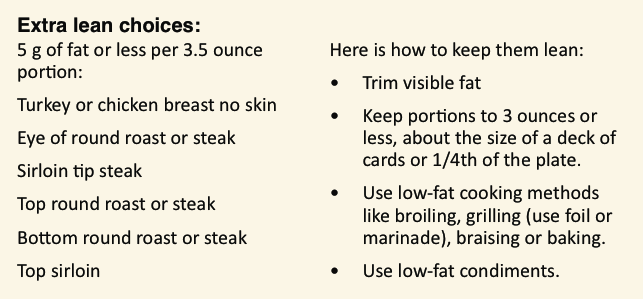Nutrition Facts for Meat
 Your next visit to the grocery store might surprise you.After years of having only voluntary Nutrition Facts labels for raw meats, those tags have now become mandatory.This means that all ground poultry and meat must sport an informative sticker that discusses its nutrient content.This rule also applies to the 40 most popular cuts of meat in the United States.Which cuts make the cut, you ask? Well, chicken breasts, lamb, steaks, veal, and pork chops all need to display a shiny new label, as do various other portions of meat.The tags must include much of the same information that is required for most Nutrition Facts labels -- total calories, calories from fat, amounts of protein, iron, sodium, cholesterol, and saturated fat, etc.If some cuts of meat cannot sport this label, due to their shape, size, or lack of packaging, the information must be listed and displayed on a poster nearby.One of the goals of this transition is to make it easier for people to make healthful decisions in the grocery store. Shoppers can compare levels of saturated fat, sodium, etc andthen choose the most nutritious option. Plus, these tags now include the total percentage of fat content. So the next time you’re in the grocery store, check out the new labels and choose a healthful cut of meat.What does this new label law means to shoppers? Follow our 3 tips:
Your next visit to the grocery store might surprise you.After years of having only voluntary Nutrition Facts labels for raw meats, those tags have now become mandatory.This means that all ground poultry and meat must sport an informative sticker that discusses its nutrient content.This rule also applies to the 40 most popular cuts of meat in the United States.Which cuts make the cut, you ask? Well, chicken breasts, lamb, steaks, veal, and pork chops all need to display a shiny new label, as do various other portions of meat.The tags must include much of the same information that is required for most Nutrition Facts labels -- total calories, calories from fat, amounts of protein, iron, sodium, cholesterol, and saturated fat, etc.If some cuts of meat cannot sport this label, due to their shape, size, or lack of packaging, the information must be listed and displayed on a poster nearby.One of the goals of this transition is to make it easier for people to make healthful decisions in the grocery store. Shoppers can compare levels of saturated fat, sodium, etc andthen choose the most nutritious option. Plus, these tags now include the total percentage of fat content. So the next time you’re in the grocery store, check out the new labels and choose a healthful cut of meat.What does this new label law means to shoppers? Follow our 3 tips:
- Instead of looking at 90% lean or other front-of-the-package nutrient claims, turn the package over and read the nutrition facts label. Total fat, saturated fat and sodium are what matter in the meat aisle. 90% lean is by weight so the total fat will not be that low. Compare to extra lean which is much lower in fat per serving.
- Beware of poultry products that are boosed with brine, which contains salt. Often the sodium in these products is high, much higher than products that do not contain brine.
- Also beware of highly seasoned or stuffed meat items that are high in sodium.
- White meat is lower in fat and saturated fat than dark meat.
- Be sure to choose ground options that don’t have any skin or dark meat.
- Beware of processed items that are high in fat and sodium.
Fish:
- In this case, you often want fattier fish, because they are high in omega-3 fatty acids. These fatty acids are very good for your health.
- The next time you go to the fish counter, try salmon, halibut, or trout.
- Beware of imitation crab and breaded items which are high in sodium and or fat.
Poultry and fish along with nuts and legumes are the best choices. If you do choose beef, here’s the scoop:Beef:
- Round and loin are some of the cuts that are lowest in fat.
- 95%-99% lean ground beef can also be a healthful choice.
- Extra large fatty cuts of meat can be cut into smaller portions and the fat trimmed away to make these better choices.
For more information on the new FDA Meat Label Law, visit:http://www.fsis.usda.gov/Regulations_&_Policies/2010_ Interim_&_Final_Rules_Index/index.asp


